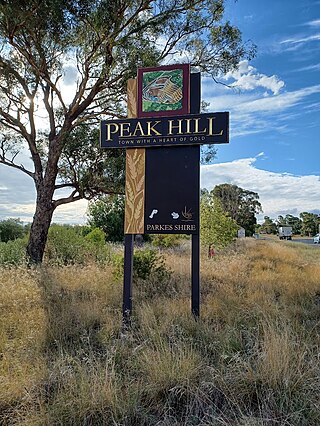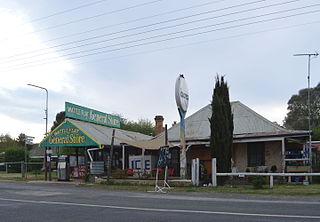
Cobar is a town in central western New South Wales, Australia whose economy is based mainly upon base metals and gold mining. The town is 712 km (442 mi) by road northwest of the state capital, Sydney. It is at the crossroads of the Kidman Way and Barrier Highway. The town and the local government area, the Cobar Shire, are on the eastern edge of the outback. At the 2016 census, the town of Cobar had a population of 3,990. The Shire has a population of approximately 4,700 and an area of 44,065 square kilometres (17,014 sq mi).

Narromine (/næroʊmaɪn/) is a rural Australian town located approximately 40 kilometres (25 mi) west of Dubbo in the Orana region of New South Wales. The town is at the centre of Narromine Shire. The 2016 census recorded a population of 3,528. Narromine holds strong historical ties to the Australian Military, as it was the location of RAAF No.19 Inland Aircraft Fuel Depot (IAFD) during World War II. The base contributed to the preparation of troops through a training organisation known as the Empire Air Training Scheme (EATS). The town was one of twelve locations for the No.5 Elementary Flying Training School RAAF in 1940.

Stuart Town, formerly known as Ironbark, is a small town on the Central Western Slopes of New South Wales, Australia within Dubbo Regional Council. It is located 317 kilometres (197 mi) north-west of the state capital, Sydney. At the 2011 census, Stuart Town had a population of 487. The area around the town is rich in cattle farming and orchards, so the town serves as a service centre to that area.

Peak Hill is a town in Parkes Shire in the Central West of New South Wales, Australia. At the 2021 census, Peak Hill had a population of 768 people. It is located on the Newell Highway and the Parkes to Narromine railway line.

Nerrigundah is a small village on the Eurobodalla Nature Coast in south eastern New South Wales. Situated at the head of the Tuross River Valley, it is nineteen kilometres inland from Bodalla. At the 2016 census, Nerrigundah had a population of 25.

Wongarbon is a village approximately 18 kilometres east of Dubbo on the Mitchell Highway between Dubbo and Wellington, New South Wales, Australia. The name is also applied to the surrounding area for postal and statistical purposes. At the 2016 census, Wongarbon had a population of 766.

Albert is a town in the Central West region of New South Wales, Australia. The town is in the Lachlan Shire local government area, 481 kilometres (299 mi) west north west of the state capital, Sydney. At the 2016 census, Albert had a population of 81, though Albert once had a population of 900.

Leadville is a town in New South Wales, Australia. The town is located in the Warrumbungle Shire local government area, 376 kilometres (234 mi) north west of the state capital, Sydney. At the 2016 census, Leadville and the surrounding area had a population of 169.

Girilambone is a small village in western New South Wales, Australia. It is located north of Nyngan and 666 km north-west of Sydney. The name is also applied to the surrounding area, for postal and statistical purposes. At the 2016 census, the population of the village and its surrounding area was only 107, but it had fallen to just 86 in 2021. The village was originally associated with copper mining.
Burraga is located in the Central Tablelands of New South Wales, 47 kilometres south west of Oberon and about 67 kilometres (42 mi) south of Bathurst. It is within Oberon Shire. At the 2016 census, Burraga had a population of 91.

Colinton is a locality in the Snowy Monaro Region, New South Wales, Australia. At the 2016 census, it had a population of 127. There was once a village and railway station of the same name.

Wattle Flat is a locality in the Bathurst Region of New South Wales, Australia. It had a population of 257 people as of the 2016 census. There is a small village of the same name, near the confluence of Big Oaky Creek and its tributary Solitary Creek.
Bobadah was a mining village, now a locality, in the Orana region of New South Wales, Australia. It was also known as Carpina, its official name, although that name was rarely used. It is now a ghost town, with its community hall being its last remaining building. Its population in 2016, including the surrounding area, was 10. It was once a larger settlement associated with the nearby Overflow Mine.

Hermidale is a village in the Orana region of New South Wales, Australia. It is 600km north-west of Sydney and the two closest towns are Nyngan and Cobar. It lies on the Barrier Highway. At the 2021 Census, the population of Hermidale was 127.

Gilgunnia is a locality and ghost town in the Orana region of New South Wales, Australia, within the Parish of South Peak in Blaxland County and Cobar Shire. It was once a settlement associated with gold mining, but in 2016 its population was zero. The nearest settlements are Mount Hope and Nymagee.

Mount Allen is a ghost town in the Orana region of New South Wales, Australia. There was once a village of the same name associated with gold mining. For statistical purposes, it is considered part of Mount Hope.
Caloola is a locality in the Central West region of New South Wales. There once was a small village of the same name but it is a ghost town today. At the 2016 census, the locality had a population of 88.
Dalmorton is a locality in the Northern Rivers region of New South Wales, Australia. There once was a village of the same name, which was associated with gold mining. Much of the area of the locality is now reserved as National Parks or State Forests. At the 2016 census, the population of Dalmorton was four.

North Yalgogrin is a locality in the Bland Shire local government area of New South Wales. There once was a village there, named Yalgogrin, but better known as Yalgogrin North.

Wrightville was a mining village in the Orana region of New South Wales, Australia. Once it was a significant settlement, with its own municipal government, public school, convent school, post office, police station, four hotels, and railway connection. At its peak, around 1907, its population probably reached 2,000 people. Its site and that of the adjacent former village of Dapville are now an uninhabited part of Cobar.

















